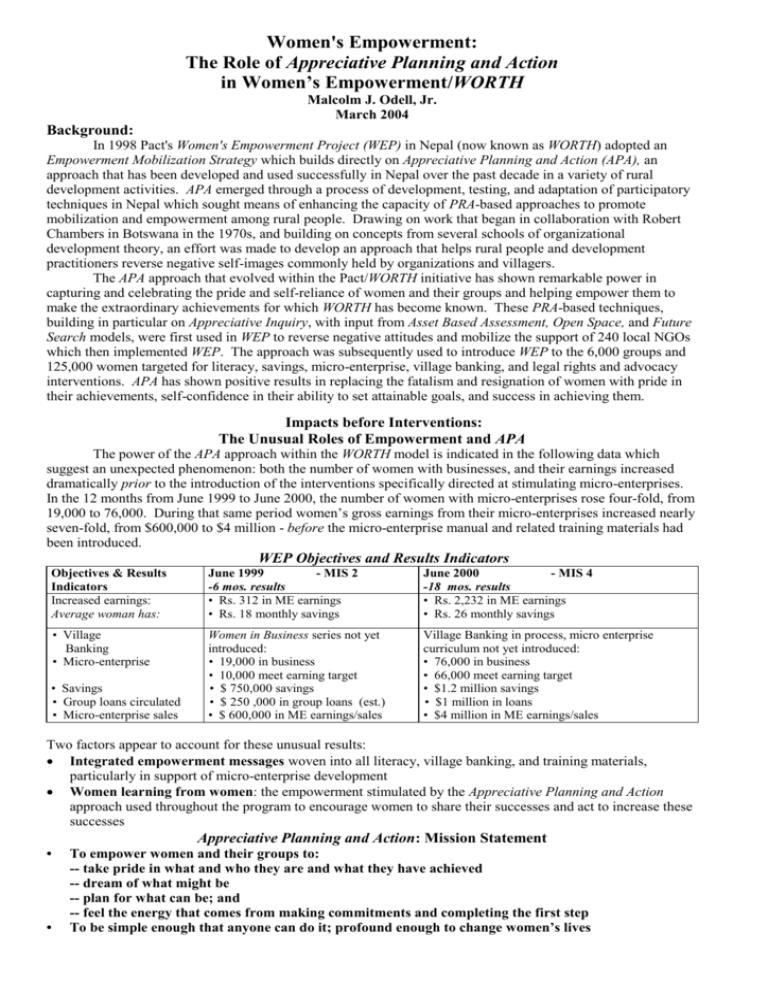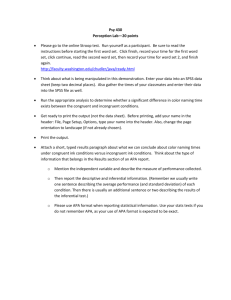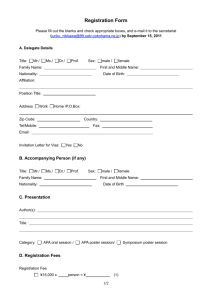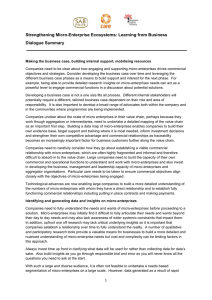APA summary/Pact - The Appreciative Inquiry Commons
advertisement

Women's Empowerment: The Role of Appreciative Planning and Action in Women’s Empowerment/WORTH Malcolm J. Odell, Jr. March 2004 Background: In 1998 Pact's Women's Empowerment Project (WEP) in Nepal (now known as WORTH) adopted an Empowerment Mobilization Strategy which builds directly on Appreciative Planning and Action (APA), an approach that has been developed and used successfully in Nepal over the past decade in a variety of rural development activities. APA emerged through a process of development, testing, and adaptation of participatory techniques in Nepal which sought means of enhancing the capacity of PRA-based approaches to promote mobilization and empowerment among rural people. Drawing on work that began in collaboration with Robert Chambers in Botswana in the 1970s, and building on concepts from several schools of organizational development theory, an effort was made to develop an approach that helps rural people and development practitioners reverse negative self-images commonly held by organizations and villagers. The APA approach that evolved within the Pact/WORTH initiative has shown remarkable power in capturing and celebrating the pride and self-reliance of women and their groups and helping empower them to make the extraordinary achievements for which WORTH has become known. These PRA-based techniques, building in particular on Appreciative Inquiry, with input from Asset Based Assessment, Open Space, and Future Search models, were first used in WEP to reverse negative attitudes and mobilize the support of 240 local NGOs which then implemented WEP. The approach was subsequently used to introduce WEP to the 6,000 groups and 125,000 women targeted for literacy, savings, micro-enterprise, village banking, and legal rights and advocacy interventions. APA has shown positive results in replacing the fatalism and resignation of women with pride in their achievements, self-confidence in their ability to set attainable goals, and success in achieving them. Impacts before Interventions: The Unusual Roles of Empowerment and APA The power of the APA approach within the WORTH model is indicated in the following data which suggest an unexpected phenomenon: both the number of women with businesses, and their earnings increased dramatically prior to the introduction of the interventions specifically directed at stimulating micro-enterprises. In the 12 months from June 1999 to June 2000, the number of women with micro-enterprises rose four-fold, from 19,000 to 76,000. During that same period women’s gross earnings from their micro-enterprises increased nearly seven-fold, from $600,000 to $4 million - before the micro-enterprise manual and related training materials had been introduced. WEP Objectives and Results Indicators Objectives & Results Indicators Increased earnings: Average woman has: June 1999 - MIS 2 -6 mos. results • Rs. 312 in ME earnings • Rs. 18 monthly savings June 2000 - MIS 4 -18 mos. results • Rs. 2,232 in ME earnings • Rs. 26 monthly savings • Village Banking • Micro-enterprise Women in Business series not yet introduced: • 19,000 in business • 10,000 meet earning target • $ 750,000 savings • $ 250 ,000 in group loans (est.) • $ 600,000 in ME earnings/sales Village Banking in process, micro enterprise curriculum not yet introduced: • 76,000 in business • 66,000 meet earning target • $1.2 million savings • $1 million in loans • $4 million in ME earnings/sales • Savings • Group loans circulated • Micro-enterprise sales Two factors appear to account for these unusual results: Integrated empowerment messages woven into all literacy, village banking, and training materials, particularly in support of micro-enterprise development Women learning from women: the empowerment stimulated by the Appreciative Planning and Action approach used throughout the program to encourage women to share their successes and act to increase these successes Appreciative Planning and Action: Mission Statement • • To empower women and their groups to: -- take pride in what and who they are and what they have achieved -- dream of what might be -- plan for what can be; and -- feel the energy that comes from making commitments and completing the first step To be simple enough that anyone can do it; profound enough to change women’s lives The Appreciative Planning and Action Model APA, as developed and used in WORTH is built on four basic elements, including a simple 4-part planning and action approach that parallels classic planning models. These include: • One goal: -- Seeking the root cause of success (not the root cause of failure) • Two laws: l What you seek is what you find (The questions you ask determine the answers you get) 2 Where you believe you are going is where you will end up • Three principles: l 2 3 If you look for problems, you find more problems If you look for successes, you find more successes If you have faith in your dreams you can achieve miracles The Four 'Ds' l Discovery -- Asking positive questions, seeking what works, what empowers, what gives life to our community or group, when have we, as women, felt particularly excited, energized, empowered? 2 Dream -- Visioning of what could be, where we want to go, what do we want for our daughters, our granddaughters? 3 Design -- Making an action plan based on what we can do for ourselves -- Making personal commitments 4 Delivery -- Start taking action, now! “A-Valuation” and Reflection: Participatory Monitoring and Evaluation (PME) The 4-D process leads directly back to the Discovery step through reviewing what has worked best, what was learned, how this affects our dream, and what new actions we can take to move forward and followup on what we have started. A simple ‘3-D’ “A-Valuation” process, using 3 simple questions, is used at the end of every session: (1) What’s the best of what we did today? (2) “What’s ‘even better’ look like? How can we do this better next time?” and (3) “How do we get there? What do we do to see that happens?” Like any sound village or organizational development process, APA initiatives require ongoing and regular follow-up: generally monthly for the first 6 months, then every 6 months thereafter until groups and/or organizations are functioning on a sustainable basis (± 2 years). The APA Process and Standard Project Planning Cycles The APA process is fully compatible with most standard project cycles which are based on a parallel 4-step process of problem identification and analysis, choice of alternatives, development of plan, implementation of plan (followed by a return to the first step as part of a monitoring/evaluation process). This new generation PRA approach thus can be introduced harmoniously into existing systems, giving new meaning and power to those systems rather than undermining or invalidating them. The fundamental difference, however, between APA and conventional planning models is its focus is on building from success to success, using achievements rather than problems, as the source of most powerful learning. Problem-Solving Planning Cycle "Felt Needs" Problem identification Analysis of causes Analysis of possible solutions Action planning Appreciative Planning and Action Appreciating and valuing the best of 'what is' Envisioning 'what might be' Dialoguing 'what should be' Innovating what 'will be' Basic Assumption: An organization is a problem to be solved Basic Assumption: An organization is an innovation, an opportunity to be explored





